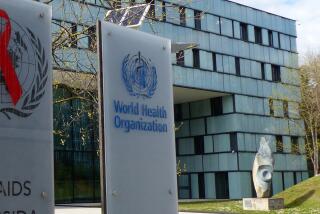Plan to Restrict AIDS-Infected Doctors Dropped
- Share via
WASHINGTON — In the face of growing defiance from the medical community, the federal government has backed away from a controversial plan to list certain medical procedures that AIDS-infected health professionals should not perform, federal health officials said Tuesday.
Instead, the federal Centers for Disease Control will more strongly urge physicians to adhere to existing infection control procedures that would help reduce the already small risk of AIDS transmission from doctor to patient, Assistant Secretary of Health James O. Mason said.
“In no way do we feel we are endangering the public,” he said in an interview. “We just feel there are other ways we can arrive at the same result.”
Mason said that health officials were persuaded by an avalanche of almost unanimous opinion from medical and public health experts that the risk of transmission of the human immunodeficiency virus during a medical procedure is so small that it would be nearly impossible “to provide data on what exposure-prone procedures were.”
In reality, Mason said, any risk, however remote, would be related more likely to the skill and experience of the surgeon than to the nature of the procedure itself. “For one practitioner, a procedure may be exposure-prone, while it would not be for another,” he said.
The decision was applauded by Jeff Levi, director of government affairs for the Washington-based AIDS Action Council, which opposed the proposed listing, believing that it would be unscientific.
“This is a recognition on the part of CDC that the focus should be on infection control,” he said. “It’s important that the CDC and the rest of the medical community speak with one voice--and now I think they can. In no way is CDC running away from this problem. They are finally addressing it in a manner based on fact, not fear.”
In July, the CDC recommended that all health care professionals who perform surgery undergo voluntary testing to determine whether they are infected with HIV and refrain from practicing unless they are cleared by a local medical review panel. The CDC also recommended that physicians disclose their condition to patients.
The agency then called on numerous medical groups to propose a list of surgical procedures that could pose a danger of transmission. Virtually all refused, saying that there was no scientific basis for such a list. The proposed guidelines also urged adherence to standard infection-control procedures used to prevent transmission of blood-borne diseases such as AIDS and hepatitis B.
Mason said the CDC will continue to stress that physicians should be tested voluntarily and go before local boards for counseling. But he said that the emphasis will shift from concern about procedures to stricter attention to universal precautions.
“CDC has recognized that there is a certain truth to what all the groups have been saying,” Mason said, noting that with the exception of a Florida case in which a dentist with AIDS apparently infected five patients, “it is very difficult to come up with data on what procedures are exposure-prone.”
The proposed CDC guidelines were released after an intense yearlong national debate after the revelation about the case involving the Florida dentist, Dr. David Acer. A young woman named Kimberly Bergalis was the first of the infected patients to be identified.
Bergalis, who became the ultimate symbol of the AIDS “innocent victim,” has served as powerful emotional ammunition for those who support greater restrictions on the practice of AIDS-infected surgeons and dentists.
But the Florida case has proved to be the only known instance of such transmission.
In the Florida case, investigators at first believed that the dentist, who has since died of AIDS, somehow mingled his own infected blood with Bergalis’ blood. But since the identification of four additional patients, the evidence points more toward a breakdown of infection control procedures.
Policy recommendations from the CDC do not have force of law but are generally influential when states and other entities determine health policy.
More to Read
Sign up for Essential California
The most important California stories and recommendations in your inbox every morning.
You may occasionally receive promotional content from the Los Angeles Times.










